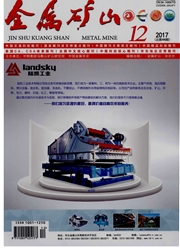

 中文摘要:
中文摘要:
内蒙古某铜钼混合精矿铜品位为26.14%、钼品位为0.93%,由于受磨矿、混浮过程中产生的铜离子活化,导致铜钼分离困难。现场采用15kg/t的硫化钠抑铜浮钼,不仅铜钼分离效果不好,而且会造成尾矿库及选矿厂周边环境污染。为解决上述问题,东北大学相关课题组分别对硫化钠和自制的DDY3用量进行了研究,并对比了DDY3和硫化钠对矿浆浓度、pH值变化的适应性,以及DDY3和硫化钠药液失效时间。结果表明:①DDY3的用量远低于硫化钠,DDY3对矿浆浓度、pH值变化的适应能力明显强于硫化钠,且DDY3的失效缓慢程度远胜于硫化钠。②在矿浆浓度均为25%、pH值均为10.5情况下,选用15kg/t的现用现配硫化钠为抑制剂,钼精矿钼品位为9.65%、钼回收率为16.23%,铜精矿铜回收率为98.96%;选用1kg/t的现用现配DDY3为抑制剂,钼精矿钼品位达10.80%、钼回收率达61.33%,铜精矿铜回收率为94.39%。DDY3替代硫化钠用于该铜钼混合精矿的分离,具有高效、环保特征。
 英文摘要:
英文摘要:
A copper and molybdenum mixed concentrate in Inner Mongolia contains 26.14% copper and 0.93% molyb- denum. Activation of copper ions produced during the process of grinding and bulk flotation makes it difficult to separate copper from molybdenum. Sodium sulfide is added by 15 kg/t to realize molybdenum floatation and copper depression in on-site process. But it does not achieve the desired effect, even worse. It results in contamination of tailings dam and surroundings. To solve the problem, the dosages of sodium sulfide and self-made DDY3 are investigated respectively by the subject team of Northeastern University,the adaptation of DDY3 and sodium sulfide to the pulp density and pH are contrasted,and the failure time of DDY3 and sodium sulfide solution are found out. The results show that: ①The dosage of DDY3 is much lower than that of sodium sulfide, and DDY3 has a much better adaptability than that of sodium sulfide in the pulp density and pH variation. And the failure time of DDY3 is much slower than sodium sulfide.②Under the conditions of pulp concentration of 25% and pH of 10.5, molybdenum concentrate with molybdenum grade of 9.65% and recovery of 16.23%, and copper concentrate with copper recovery of 98.96% are received by adopting 15 kg/t fresh sodium sulfide. Molybdenum concentrate with molybdenum grade of 10.80% and recovery of 61.33% ,and copper concentrate with copper recovery of 94.39% are received with 1 kg/t fresh DDY3. That DDY3 instead of sodium sulfide is used in separation of copper molybdenum mixed concentrate are high effi- cient and environmental-friendly.
 同期刊论文项目
同期刊论文项目
 同项目期刊论文
同项目期刊论文
 期刊信息
期刊信息
